Nagasaki prints Stock Photos and Images
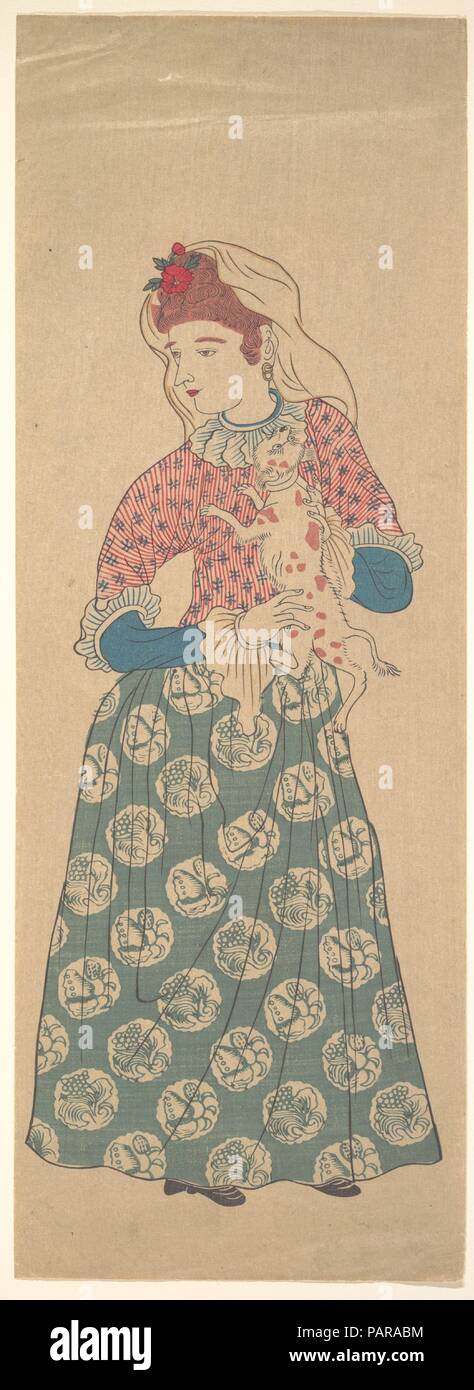 Dutch Woman Holding a Dog. Artist: Unidentified Artist. Culture: Japan. Dimensions: Image: 17 1/16 x 6 1/8 in. (43.3 x 15.6 cm). Date: first half of the 19th century. This print was not produced in Yokohama but rather in Nagasaki, the only port open to foreign trade until the end of the Edo period and thus Japan's only window to foreign countries. Nagasaki prints usually illustrated exotic sailing ships and Dutch and Chinese people. They were an important source for Yokohama prints. Museum: Metropolitan Museum of Art, New York, USA. Stock Photohttps://www.alamy.com/image-license-details/?v=1https://www.alamy.com/dutch-woman-holding-a-dog-artist-unidentified-artist-culture-japan-dimensions-image-17-116-x-6-18-in-433-x-156-cm-date-first-half-of-the-19th-century-this-print-was-not-produced-in-yokohama-but-rather-in-nagasaki-the-only-port-open-to-foreign-trade-until-the-end-of-the-edo-period-and-thus-japans-only-window-to-foreign-countries-nagasaki-prints-usually-illustrated-exotic-sailing-ships-and-dutch-and-chinese-people-they-were-an-important-source-for-yokohama-prints-museum-metropolitan-museum-of-art-new-york-usa-image213184040.html
Dutch Woman Holding a Dog. Artist: Unidentified Artist. Culture: Japan. Dimensions: Image: 17 1/16 x 6 1/8 in. (43.3 x 15.6 cm). Date: first half of the 19th century. This print was not produced in Yokohama but rather in Nagasaki, the only port open to foreign trade until the end of the Edo period and thus Japan's only window to foreign countries. Nagasaki prints usually illustrated exotic sailing ships and Dutch and Chinese people. They were an important source for Yokohama prints. Museum: Metropolitan Museum of Art, New York, USA. Stock Photohttps://www.alamy.com/image-license-details/?v=1https://www.alamy.com/dutch-woman-holding-a-dog-artist-unidentified-artist-culture-japan-dimensions-image-17-116-x-6-18-in-433-x-156-cm-date-first-half-of-the-19th-century-this-print-was-not-produced-in-yokohama-but-rather-in-nagasaki-the-only-port-open-to-foreign-trade-until-the-end-of-the-edo-period-and-thus-japans-only-window-to-foreign-countries-nagasaki-prints-usually-illustrated-exotic-sailing-ships-and-dutch-and-chinese-people-they-were-an-important-source-for-yokohama-prints-museum-metropolitan-museum-of-art-new-york-usa-image213184040.htmlRMPARABM–Dutch Woman Holding a Dog. Artist: Unidentified Artist. Culture: Japan. Dimensions: Image: 17 1/16 x 6 1/8 in. (43.3 x 15.6 cm). Date: first half of the 19th century. This print was not produced in Yokohama but rather in Nagasaki, the only port open to foreign trade until the end of the Edo period and thus Japan's only window to foreign countries. Nagasaki prints usually illustrated exotic sailing ships and Dutch and Chinese people. They were an important source for Yokohama prints. Museum: Metropolitan Museum of Art, New York, USA.
 Dutch Woman Holding a Dog first half of the 19th century Unidentified artist This print was not produced in Yokohama but rather in Nagasaki, the only port open to foreign trade until the end of the Edo period and thus Japan's only window to foreign countries. Nagasaki prints usually illustrated exotic sailing ships and Dutch and Chinese people. They were an important source for Yokohama prints.. Dutch Woman Holding a Dog 55405 Stock Photohttps://www.alamy.com/image-license-details/?v=1https://www.alamy.com/dutch-woman-holding-a-dog-first-half-of-the-19th-century-unidentified-artist-this-print-was-not-produced-in-yokohama-but-rather-in-nagasaki-the-only-port-open-to-foreign-trade-until-the-end-of-the-edo-period-and-thus-japans-only-window-to-foreign-countries-nagasaki-prints-usually-illustrated-exotic-sailing-ships-and-dutch-and-chinese-people-they-were-an-important-source-for-yokohama-prints-dutch-woman-holding-a-dog-55405-image458641361.html
Dutch Woman Holding a Dog first half of the 19th century Unidentified artist This print was not produced in Yokohama but rather in Nagasaki, the only port open to foreign trade until the end of the Edo period and thus Japan's only window to foreign countries. Nagasaki prints usually illustrated exotic sailing ships and Dutch and Chinese people. They were an important source for Yokohama prints.. Dutch Woman Holding a Dog 55405 Stock Photohttps://www.alamy.com/image-license-details/?v=1https://www.alamy.com/dutch-woman-holding-a-dog-first-half-of-the-19th-century-unidentified-artist-this-print-was-not-produced-in-yokohama-but-rather-in-nagasaki-the-only-port-open-to-foreign-trade-until-the-end-of-the-edo-period-and-thus-japans-only-window-to-foreign-countries-nagasaki-prints-usually-illustrated-exotic-sailing-ships-and-dutch-and-chinese-people-they-were-an-important-source-for-yokohama-prints-dutch-woman-holding-a-dog-55405-image458641361.htmlRM2HJ4WMH–Dutch Woman Holding a Dog first half of the 19th century Unidentified artist This print was not produced in Yokohama but rather in Nagasaki, the only port open to foreign trade until the end of the Edo period and thus Japan's only window to foreign countries. Nagasaki prints usually illustrated exotic sailing ships and Dutch and Chinese people. They were an important source for Yokohama prints.. Dutch Woman Holding a Dog 55405
 Unidentified Artist, Chinese Ships at Nagasaki, Japan, Edo period (1615–1868), Unidentified Artist Japanese, 19th century, ca. 1840, Japan, Polychrome woodblock print; ink and color on paper, Sheet: 6 3/8 x 18 3/16 in. (16.2 x 46.2 cm), Prints Stock Photohttps://www.alamy.com/image-license-details/?v=1https://www.alamy.com/unidentified-artist-chinese-ships-at-nagasaki-japan-edo-period-16151868-unidentified-artist-japanese-19th-century-ca-1840-japan-polychrome-woodblock-print-ink-and-color-on-paper-sheet-6-38-x-18-316-in-162-x-462-cm-prints-image344661588.html
Unidentified Artist, Chinese Ships at Nagasaki, Japan, Edo period (1615–1868), Unidentified Artist Japanese, 19th century, ca. 1840, Japan, Polychrome woodblock print; ink and color on paper, Sheet: 6 3/8 x 18 3/16 in. (16.2 x 46.2 cm), Prints Stock Photohttps://www.alamy.com/image-license-details/?v=1https://www.alamy.com/unidentified-artist-chinese-ships-at-nagasaki-japan-edo-period-16151868-unidentified-artist-japanese-19th-century-ca-1840-japan-polychrome-woodblock-print-ink-and-color-on-paper-sheet-6-38-x-18-316-in-162-x-462-cm-prints-image344661588.htmlRM2B0MKAC–Unidentified Artist, Chinese Ships at Nagasaki, Japan, Edo period (1615–1868), Unidentified Artist Japanese, 19th century, ca. 1840, Japan, Polychrome woodblock print; ink and color on paper, Sheet: 6 3/8 x 18 3/16 in. (16.2 x 46.2 cm), Prints
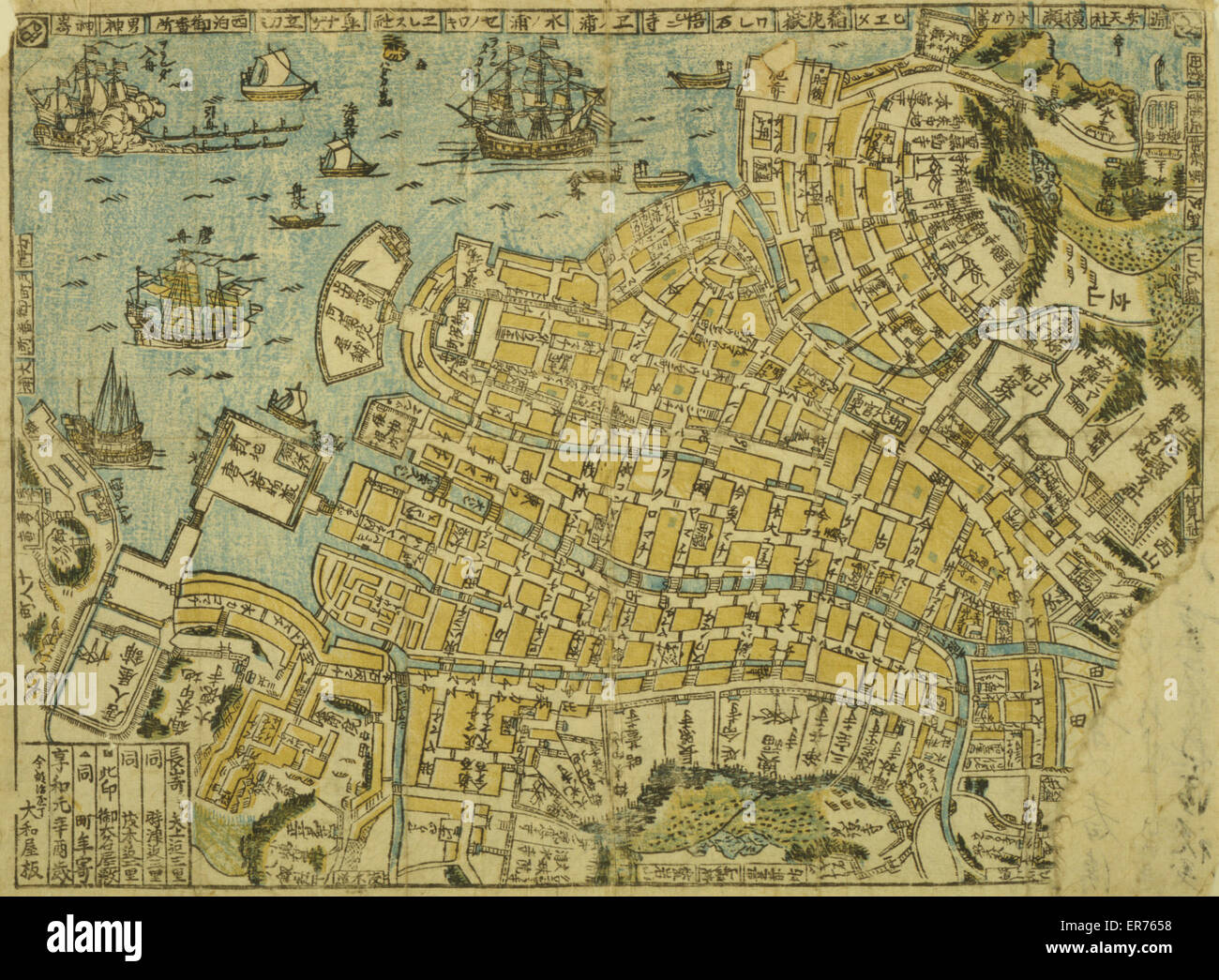 Map of Nagasaki Stock Photohttps://www.alamy.com/image-license-details/?v=1https://www.alamy.com/stock-photo-map-of-nagasaki-83137076.html
Map of Nagasaki Stock Photohttps://www.alamy.com/image-license-details/?v=1https://www.alamy.com/stock-photo-map-of-nagasaki-83137076.htmlRMER7658–Map of Nagasaki
 Painting of the Nagasaki Martyrs - 26 men and boys who died on a hill of crosses outside Nagasaki - February 5th, 1597 Stock Photohttps://www.alamy.com/image-license-details/?v=1https://www.alamy.com/painting-of-the-nagasaki-martyrs-26-men-and-boys-who-died-on-a-hill-of-crosses-outside-nagasaki-february-5th-1597-image450463122.html
Painting of the Nagasaki Martyrs - 26 men and boys who died on a hill of crosses outside Nagasaki - February 5th, 1597 Stock Photohttps://www.alamy.com/image-license-details/?v=1https://www.alamy.com/painting-of-the-nagasaki-martyrs-26-men-and-boys-who-died-on-a-hill-of-crosses-outside-nagasaki-february-5th-1597-image450463122.htmlRF2H4TA8J–Painting of the Nagasaki Martyrs - 26 men and boys who died on a hill of crosses outside Nagasaki - February 5th, 1597
![View of the garden from the veranda of a Japanese tea house. There's a dog sleeping on the porch. In the garden palms or tree ferns, a garden statue of a crane and a garden lantern. Japan, place unknown [possibly surroundings of Nagasaki], undated [Photo belonging to a series of 42 prints in the collection of Savings City Photo by Felice Beato, Kusakabe Kimbei or Baron Raimund von Stillfried]. Based on Claudia Gabriele Philipp, Dietmar Siegert, Rainer Wick (ed), Felice Beato In Japan; Photographien zum Ende der Feudalzeit 1863 1873, Heidelberg/M 1991, page 98, this image is attributable to Fel Stock Photo View of the garden from the veranda of a Japanese tea house. There's a dog sleeping on the porch. In the garden palms or tree ferns, a garden statue of a crane and a garden lantern. Japan, place unknown [possibly surroundings of Nagasaki], undated [Photo belonging to a series of 42 prints in the collection of Savings City Photo by Felice Beato, Kusakabe Kimbei or Baron Raimund von Stillfried]. Based on Claudia Gabriele Philipp, Dietmar Siegert, Rainer Wick (ed), Felice Beato In Japan; Photographien zum Ende der Feudalzeit 1863 1873, Heidelberg/M 1991, page 98, this image is attributable to Fel Stock Photo](https://c8.alamy.com/comp/2APY92J/view-of-the-garden-from-the-veranda-of-a-japanese-tea-house-theres-a-dog-sleeping-on-the-porch-in-the-garden-palms-or-tree-ferns-a-garden-statue-of-a-crane-and-a-garden-lantern-japan-place-unknown-possibly-surroundings-of-nagasaki-undated-photo-belonging-to-a-series-of-42-prints-in-the-collection-of-savings-city-photo-by-felice-beato-kusakabe-kimbei-or-baron-raimund-von-stillfried-based-on-claudia-gabriele-philipp-dietmar-siegert-rainer-wick-ed-felice-beato-in-japan-photographien-zum-ende-der-feudalzeit-1863-1873-heidelbergm-1991-page-98-this-image-is-attributable-to-fel-2APY92J.jpg) View of the garden from the veranda of a Japanese tea house. There's a dog sleeping on the porch. In the garden palms or tree ferns, a garden statue of a crane and a garden lantern. Japan, place unknown [possibly surroundings of Nagasaki], undated [Photo belonging to a series of 42 prints in the collection of Savings City Photo by Felice Beato, Kusakabe Kimbei or Baron Raimund von Stillfried]. Based on Claudia Gabriele Philipp, Dietmar Siegert, Rainer Wick (ed), Felice Beato In Japan; Photographien zum Ende der Feudalzeit 1863 1873, Heidelberg/M 1991, page 98, this image is attributable to Fel Stock Photohttps://www.alamy.com/image-license-details/?v=1https://www.alamy.com/view-of-the-garden-from-the-veranda-of-a-japanese-tea-house-theres-a-dog-sleeping-on-the-porch-in-the-garden-palms-or-tree-ferns-a-garden-statue-of-a-crane-and-a-garden-lantern-japan-place-unknown-possibly-surroundings-of-nagasaki-undated-photo-belonging-to-a-series-of-42-prints-in-the-collection-of-savings-city-photo-by-felice-beato-kusakabe-kimbei-or-baron-raimund-von-stillfried-based-on-claudia-gabriele-philipp-dietmar-siegert-rainer-wick-ed-felice-beato-in-japan-photographien-zum-ende-der-feudalzeit-1863-1873-heidelbergm-1991-page-98-this-image-is-attributable-to-fel-image341119258.html
View of the garden from the veranda of a Japanese tea house. There's a dog sleeping on the porch. In the garden palms or tree ferns, a garden statue of a crane and a garden lantern. Japan, place unknown [possibly surroundings of Nagasaki], undated [Photo belonging to a series of 42 prints in the collection of Savings City Photo by Felice Beato, Kusakabe Kimbei or Baron Raimund von Stillfried]. Based on Claudia Gabriele Philipp, Dietmar Siegert, Rainer Wick (ed), Felice Beato In Japan; Photographien zum Ende der Feudalzeit 1863 1873, Heidelberg/M 1991, page 98, this image is attributable to Fel Stock Photohttps://www.alamy.com/image-license-details/?v=1https://www.alamy.com/view-of-the-garden-from-the-veranda-of-a-japanese-tea-house-theres-a-dog-sleeping-on-the-porch-in-the-garden-palms-or-tree-ferns-a-garden-statue-of-a-crane-and-a-garden-lantern-japan-place-unknown-possibly-surroundings-of-nagasaki-undated-photo-belonging-to-a-series-of-42-prints-in-the-collection-of-savings-city-photo-by-felice-beato-kusakabe-kimbei-or-baron-raimund-von-stillfried-based-on-claudia-gabriele-philipp-dietmar-siegert-rainer-wick-ed-felice-beato-in-japan-photographien-zum-ende-der-feudalzeit-1863-1873-heidelbergm-1991-page-98-this-image-is-attributable-to-fel-image341119258.htmlRM2APY92J–View of the garden from the veranda of a Japanese tea house. There's a dog sleeping on the porch. In the garden palms or tree ferns, a garden statue of a crane and a garden lantern. Japan, place unknown [possibly surroundings of Nagasaki], undated [Photo belonging to a series of 42 prints in the collection of Savings City Photo by Felice Beato, Kusakabe Kimbei or Baron Raimund von Stillfried]. Based on Claudia Gabriele Philipp, Dietmar Siegert, Rainer Wick (ed), Felice Beato In Japan; Photographien zum Ende der Feudalzeit 1863 1873, Heidelberg/M 1991, page 98, this image is attributable to Fel
 Art inspired by Dutch Woman Holding a Dog, Edo period (1615–1868), first half of the 19th century, Japan, Polychrome woodblock print; ink and color on paper, Image: 17 1/16 x 6 1/8 in. (43.3 x 15.6 cm), Prints, Unidentified Artist, This print was not produced in Yokohama but rather in, Classic works modernized by Artotop with a splash of modernity. Shapes, color and value, eye-catching visual impact on art. Emotions through freedom of artworks in a contemporary way. A timeless message pursuing a wildly creative new direction. Artists turning to the digital medium and creating the Artotop NFT Stock Photohttps://www.alamy.com/image-license-details/?v=1https://www.alamy.com/art-inspired-by-dutch-woman-holding-a-dog-edo-period-16151868-first-half-of-the-19th-century-japan-polychrome-woodblock-print-ink-and-color-on-paper-image-17-116-x-6-18-in-433-x-156-cm-prints-unidentified-artist-this-print-was-not-produced-in-yokohama-but-rather-in-classic-works-modernized-by-artotop-with-a-splash-of-modernity-shapes-color-and-value-eye-catching-visual-impact-on-art-emotions-through-freedom-of-artworks-in-a-contemporary-way-a-timeless-message-pursuing-a-wildly-creative-new-direction-artists-turning-to-the-digital-medium-and-creating-the-artotop-nft-image462915759.html
Art inspired by Dutch Woman Holding a Dog, Edo period (1615–1868), first half of the 19th century, Japan, Polychrome woodblock print; ink and color on paper, Image: 17 1/16 x 6 1/8 in. (43.3 x 15.6 cm), Prints, Unidentified Artist, This print was not produced in Yokohama but rather in, Classic works modernized by Artotop with a splash of modernity. Shapes, color and value, eye-catching visual impact on art. Emotions through freedom of artworks in a contemporary way. A timeless message pursuing a wildly creative new direction. Artists turning to the digital medium and creating the Artotop NFT Stock Photohttps://www.alamy.com/image-license-details/?v=1https://www.alamy.com/art-inspired-by-dutch-woman-holding-a-dog-edo-period-16151868-first-half-of-the-19th-century-japan-polychrome-woodblock-print-ink-and-color-on-paper-image-17-116-x-6-18-in-433-x-156-cm-prints-unidentified-artist-this-print-was-not-produced-in-yokohama-but-rather-in-classic-works-modernized-by-artotop-with-a-splash-of-modernity-shapes-color-and-value-eye-catching-visual-impact-on-art-emotions-through-freedom-of-artworks-in-a-contemporary-way-a-timeless-message-pursuing-a-wildly-creative-new-direction-artists-turning-to-the-digital-medium-and-creating-the-artotop-nft-image462915759.htmlRF2HW3HNK–Art inspired by Dutch Woman Holding a Dog, Edo period (1615–1868), first half of the 19th century, Japan, Polychrome woodblock print; ink and color on paper, Image: 17 1/16 x 6 1/8 in. (43.3 x 15.6 cm), Prints, Unidentified Artist, This print was not produced in Yokohama but rather in, Classic works modernized by Artotop with a splash of modernity. Shapes, color and value, eye-catching visual impact on art. Emotions through freedom of artworks in a contemporary way. A timeless message pursuing a wildly creative new direction. Artists turning to the digital medium and creating the Artotop NFT
![A Japanese man pulling a large cart containing pots, baskets, brushes, brooms etc. [Spalding collection]. Japan, 1890's. [Prints 35-46 are commercial hand-coloured photographs of Fuji-san, Chuzenji Lake, Nikko, Oji, Nagasaki and Yokohama in Japan.]. Source: Photo 335/7(46). Author: ANON. Stock Photo A Japanese man pulling a large cart containing pots, baskets, brushes, brooms etc. [Spalding collection]. Japan, 1890's. [Prints 35-46 are commercial hand-coloured photographs of Fuji-san, Chuzenji Lake, Nikko, Oji, Nagasaki and Yokohama in Japan.]. Source: Photo 335/7(46). Author: ANON. Stock Photo](https://c8.alamy.com/comp/R5913G/a-japanese-man-pulling-a-large-cart-containing-pots-baskets-brushes-brooms-etc-spalding-collection-japan-1890s-prints-35-46-are-commercial-hand-coloured-photographs-of-fuji-san-chuzenji-lake-nikko-oji-nagasaki-and-yokohama-in-japan-source-photo-335746-author-anon-R5913G.jpg) A Japanese man pulling a large cart containing pots, baskets, brushes, brooms etc. [Spalding collection]. Japan, 1890's. [Prints 35-46 are commercial hand-coloured photographs of Fuji-san, Chuzenji Lake, Nikko, Oji, Nagasaki and Yokohama in Japan.]. Source: Photo 335/7(46). Author: ANON. Stock Photohttps://www.alamy.com/image-license-details/?v=1https://www.alamy.com/a-japanese-man-pulling-a-large-cart-containing-pots-baskets-brushes-brooms-etc-spalding-collection-japan-1890s-prints-35-46-are-commercial-hand-coloured-photographs-of-fuji-san-chuzenji-lake-nikko-oji-nagasaki-and-yokohama-in-japan-source-photo-335746-author-anon-image227006516.html
A Japanese man pulling a large cart containing pots, baskets, brushes, brooms etc. [Spalding collection]. Japan, 1890's. [Prints 35-46 are commercial hand-coloured photographs of Fuji-san, Chuzenji Lake, Nikko, Oji, Nagasaki and Yokohama in Japan.]. Source: Photo 335/7(46). Author: ANON. Stock Photohttps://www.alamy.com/image-license-details/?v=1https://www.alamy.com/a-japanese-man-pulling-a-large-cart-containing-pots-baskets-brushes-brooms-etc-spalding-collection-japan-1890s-prints-35-46-are-commercial-hand-coloured-photographs-of-fuji-san-chuzenji-lake-nikko-oji-nagasaki-and-yokohama-in-japan-source-photo-335746-author-anon-image227006516.htmlRMR5913G–A Japanese man pulling a large cart containing pots, baskets, brushes, brooms etc. [Spalding collection]. Japan, 1890's. [Prints 35-46 are commercial hand-coloured photographs of Fuji-san, Chuzenji Lake, Nikko, Oji, Nagasaki and Yokohama in Japan.]. Source: Photo 335/7(46). Author: ANON.
 Dutchman with a Servant early 19th century Attributed to Kawahara Keiga This is painting was inspired by an early print of the 1750s entitled “Hollander” (Orandajin no zu) that was produced by the publisher Hariya in Nagasaki, the only port foreigners were allowed to enter Japan for most of the Edo period. That print, which became a template for countless subsequent prints and paintings of Dutch figures, identifies the dandily dressed figure with bright blue eyes and long, curly blond hair as the kapitan, referring to the opperhoofd, the manager of the Dutch factory on the island of Deshima (o Stock Photohttps://www.alamy.com/image-license-details/?v=1https://www.alamy.com/dutchman-with-a-servant-early-19th-century-attributed-to-kawahara-keiga-this-is-painting-was-inspired-by-an-early-print-of-the-1750s-entitled-hollander-orandajin-no-zu-that-was-produced-by-the-publisher-hariya-in-nagasaki-the-only-port-foreigners-were-allowed-to-enter-japan-for-most-of-the-edo-period-that-print-which-became-a-template-for-countless-subsequent-prints-and-paintings-of-dutch-figures-identifies-the-dandily-dressed-figure-with-bright-blue-eyes-and-long-curly-blond-hair-as-the-kapitan-referring-to-the-opperhoofd-the-manager-of-the-dutch-factory-on-the-island-of-deshima-o-image457848415.html
Dutchman with a Servant early 19th century Attributed to Kawahara Keiga This is painting was inspired by an early print of the 1750s entitled “Hollander” (Orandajin no zu) that was produced by the publisher Hariya in Nagasaki, the only port foreigners were allowed to enter Japan for most of the Edo period. That print, which became a template for countless subsequent prints and paintings of Dutch figures, identifies the dandily dressed figure with bright blue eyes and long, curly blond hair as the kapitan, referring to the opperhoofd, the manager of the Dutch factory on the island of Deshima (o Stock Photohttps://www.alamy.com/image-license-details/?v=1https://www.alamy.com/dutchman-with-a-servant-early-19th-century-attributed-to-kawahara-keiga-this-is-painting-was-inspired-by-an-early-print-of-the-1750s-entitled-hollander-orandajin-no-zu-that-was-produced-by-the-publisher-hariya-in-nagasaki-the-only-port-foreigners-were-allowed-to-enter-japan-for-most-of-the-edo-period-that-print-which-became-a-template-for-countless-subsequent-prints-and-paintings-of-dutch-figures-identifies-the-dandily-dressed-figure-with-bright-blue-eyes-and-long-curly-blond-hair-as-the-kapitan-referring-to-the-opperhoofd-the-manager-of-the-dutch-factory-on-the-island-of-deshima-o-image457848415.htmlRM2HGTP93–Dutchman with a Servant early 19th century Attributed to Kawahara Keiga This is painting was inspired by an early print of the 1750s entitled “Hollander” (Orandajin no zu) that was produced by the publisher Hariya in Nagasaki, the only port foreigners were allowed to enter Japan for most of the Edo period. That print, which became a template for countless subsequent prints and paintings of Dutch figures, identifies the dandily dressed figure with bright blue eyes and long, curly blond hair as the kapitan, referring to the opperhoofd, the manager of the Dutch factory on the island of Deshima (o
 Mitsuuji in the Maruyama Pleasure District of Nagasaki (Nagasaki dejima), 3rd month, 1861. Stock Photohttps://www.alamy.com/image-license-details/?v=1https://www.alamy.com/mitsuuji-in-the-maruyama-pleasure-district-of-nagasaki-nagasaki-dejima-3rd-month-1861-image374766197.html
Mitsuuji in the Maruyama Pleasure District of Nagasaki (Nagasaki dejima), 3rd month, 1861. Stock Photohttps://www.alamy.com/image-license-details/?v=1https://www.alamy.com/mitsuuji-in-the-maruyama-pleasure-district-of-nagasaki-nagasaki-dejima-3rd-month-1861-image374766197.htmlRM2CNM231–Mitsuuji in the Maruyama Pleasure District of Nagasaki (Nagasaki dejima), 3rd month, 1861.
 Chinese Ships at Nagasaki ca. 1840 Unidentified artist Two Chinese ships approach the port of Nagasaki. The crew of the ship in the foreground works quickly to lower one of the sails as a small vessel approaches with a group of returning traders. An inscription at upper left declares the ships as trading vessels from Qing, China. It is followed by an inscription detailing the mission. The red seal at right bears the name of the print’s publisher, “Bunsaid?.”. Chinese Ships at Nagasaki. Unidentified artist Japanese, 19th century. Japan. ca. 1840. Woodblock print (nishiki-e); ink and color on pa Stock Photohttps://www.alamy.com/image-license-details/?v=1https://www.alamy.com/chinese-ships-at-nagasaki-ca-1840-unidentified-artist-two-chinese-ships-approach-the-port-of-nagasaki-the-crew-of-the-ship-in-the-foreground-works-quickly-to-lower-one-of-the-sails-as-a-small-vessel-approaches-with-a-group-of-returning-traders-an-inscription-at-upper-left-declares-the-ships-as-trading-vessels-from-qing-china-it-is-followed-by-an-inscription-detailing-the-mission-the-red-seal-at-right-bears-the-name-of-the-prints-publisher-bunsaid-chinese-ships-at-nagasaki-unidentified-artist-japanese-19th-century-japan-ca-1840-woodblock-print-nishiki-e-ink-and-color-on-pa-image458627324.html
Chinese Ships at Nagasaki ca. 1840 Unidentified artist Two Chinese ships approach the port of Nagasaki. The crew of the ship in the foreground works quickly to lower one of the sails as a small vessel approaches with a group of returning traders. An inscription at upper left declares the ships as trading vessels from Qing, China. It is followed by an inscription detailing the mission. The red seal at right bears the name of the print’s publisher, “Bunsaid?.”. Chinese Ships at Nagasaki. Unidentified artist Japanese, 19th century. Japan. ca. 1840. Woodblock print (nishiki-e); ink and color on pa Stock Photohttps://www.alamy.com/image-license-details/?v=1https://www.alamy.com/chinese-ships-at-nagasaki-ca-1840-unidentified-artist-two-chinese-ships-approach-the-port-of-nagasaki-the-crew-of-the-ship-in-the-foreground-works-quickly-to-lower-one-of-the-sails-as-a-small-vessel-approaches-with-a-group-of-returning-traders-an-inscription-at-upper-left-declares-the-ships-as-trading-vessels-from-qing-china-it-is-followed-by-an-inscription-detailing-the-mission-the-red-seal-at-right-bears-the-name-of-the-prints-publisher-bunsaid-chinese-ships-at-nagasaki-unidentified-artist-japanese-19th-century-japan-ca-1840-woodblock-print-nishiki-e-ink-and-color-on-pa-image458627324.htmlRM2HJ47R8–Chinese Ships at Nagasaki ca. 1840 Unidentified artist Two Chinese ships approach the port of Nagasaki. The crew of the ship in the foreground works quickly to lower one of the sails as a small vessel approaches with a group of returning traders. An inscription at upper left declares the ships as trading vessels from Qing, China. It is followed by an inscription detailing the mission. The red seal at right bears the name of the print’s publisher, “Bunsaid?.”. Chinese Ships at Nagasaki. Unidentified artist Japanese, 19th century. Japan. ca. 1840. Woodblock print (nishiki-e); ink and color on pa
 Nagata no baba sannogu Stock Photohttps://www.alamy.com/image-license-details/?v=1https://www.alamy.com/stock-photo-nagata-no-baba-sannogu-15778222.html
Nagata no baba sannogu Stock Photohttps://www.alamy.com/image-license-details/?v=1https://www.alamy.com/stock-photo-nagata-no-baba-sannogu-15778222.htmlRMAPFNJR–Nagata no baba sannogu
![Russians at Nagasaki ca. 1830 Unidentified artist Russian officer Nikolay Rezanov (1764–1807) stands in the port of Nagasaki. He faces a soldier at left, and his attendant, at right, holds a Russian flag. A yellow cartouche at upper left reads “Illustration of Russians who arrived at Nagasaki in the ninth month of the first year of the Bunka era [1804].”. Russians at Nagasaki. Unidentified artist Japanese, 19th century. Japan. ca. 1830. Woodblock print (kappazuri); ink and stencil-printed color on paper; vertical aiban. Edo period (1615–1868). Prints Stock Photo Russians at Nagasaki ca. 1830 Unidentified artist Russian officer Nikolay Rezanov (1764–1807) stands in the port of Nagasaki. He faces a soldier at left, and his attendant, at right, holds a Russian flag. A yellow cartouche at upper left reads “Illustration of Russians who arrived at Nagasaki in the ninth month of the first year of the Bunka era [1804].”. Russians at Nagasaki. Unidentified artist Japanese, 19th century. Japan. ca. 1830. Woodblock print (kappazuri); ink and stencil-printed color on paper; vertical aiban. Edo period (1615–1868). Prints Stock Photo](https://c8.alamy.com/comp/2HHW8ED/russians-at-nagasaki-ca-1830-unidentified-artist-russian-officer-nikolay-rezanov-17641807-stands-in-the-port-of-nagasaki-he-faces-a-soldier-at-left-and-his-attendant-at-right-holds-a-russian-flag-a-yellow-cartouche-at-upper-left-reads-illustration-of-russians-who-arrived-at-nagasaki-in-the-ninth-month-of-the-first-year-of-the-bunka-era-1804-russians-at-nagasaki-unidentified-artist-japanese-19th-century-japan-ca-1830-woodblock-print-kappazuri-ink-and-stencil-printed-color-on-paper-vertical-aiban-edo-period-16151868-prints-2HHW8ED.jpg) Russians at Nagasaki ca. 1830 Unidentified artist Russian officer Nikolay Rezanov (1764–1807) stands in the port of Nagasaki. He faces a soldier at left, and his attendant, at right, holds a Russian flag. A yellow cartouche at upper left reads “Illustration of Russians who arrived at Nagasaki in the ninth month of the first year of the Bunka era [1804].”. Russians at Nagasaki. Unidentified artist Japanese, 19th century. Japan. ca. 1830. Woodblock print (kappazuri); ink and stencil-printed color on paper; vertical aiban. Edo period (1615–1868). Prints Stock Photohttps://www.alamy.com/image-license-details/?v=1https://www.alamy.com/russians-at-nagasaki-ca-1830-unidentified-artist-russian-officer-nikolay-rezanov-17641807-stands-in-the-port-of-nagasaki-he-faces-a-soldier-at-left-and-his-attendant-at-right-holds-a-russian-flag-a-yellow-cartouche-at-upper-left-reads-illustration-of-russians-who-arrived-at-nagasaki-in-the-ninth-month-of-the-first-year-of-the-bunka-era-1804-russians-at-nagasaki-unidentified-artist-japanese-19th-century-japan-ca-1830-woodblock-print-kappazuri-ink-and-stencil-printed-color-on-paper-vertical-aiban-edo-period-16151868-prints-image458474197.html
Russians at Nagasaki ca. 1830 Unidentified artist Russian officer Nikolay Rezanov (1764–1807) stands in the port of Nagasaki. He faces a soldier at left, and his attendant, at right, holds a Russian flag. A yellow cartouche at upper left reads “Illustration of Russians who arrived at Nagasaki in the ninth month of the first year of the Bunka era [1804].”. Russians at Nagasaki. Unidentified artist Japanese, 19th century. Japan. ca. 1830. Woodblock print (kappazuri); ink and stencil-printed color on paper; vertical aiban. Edo period (1615–1868). Prints Stock Photohttps://www.alamy.com/image-license-details/?v=1https://www.alamy.com/russians-at-nagasaki-ca-1830-unidentified-artist-russian-officer-nikolay-rezanov-17641807-stands-in-the-port-of-nagasaki-he-faces-a-soldier-at-left-and-his-attendant-at-right-holds-a-russian-flag-a-yellow-cartouche-at-upper-left-reads-illustration-of-russians-who-arrived-at-nagasaki-in-the-ninth-month-of-the-first-year-of-the-bunka-era-1804-russians-at-nagasaki-unidentified-artist-japanese-19th-century-japan-ca-1830-woodblock-print-kappazuri-ink-and-stencil-printed-color-on-paper-vertical-aiban-edo-period-16151868-prints-image458474197.htmlRM2HHW8ED–Russians at Nagasaki ca. 1830 Unidentified artist Russian officer Nikolay Rezanov (1764–1807) stands in the port of Nagasaki. He faces a soldier at left, and his attendant, at right, holds a Russian flag. A yellow cartouche at upper left reads “Illustration of Russians who arrived at Nagasaki in the ninth month of the first year of the Bunka era [1804].”. Russians at Nagasaki. Unidentified artist Japanese, 19th century. Japan. ca. 1830. Woodblock print (kappazuri); ink and stencil-printed color on paper; vertical aiban. Edo period (1615–1868). Prints
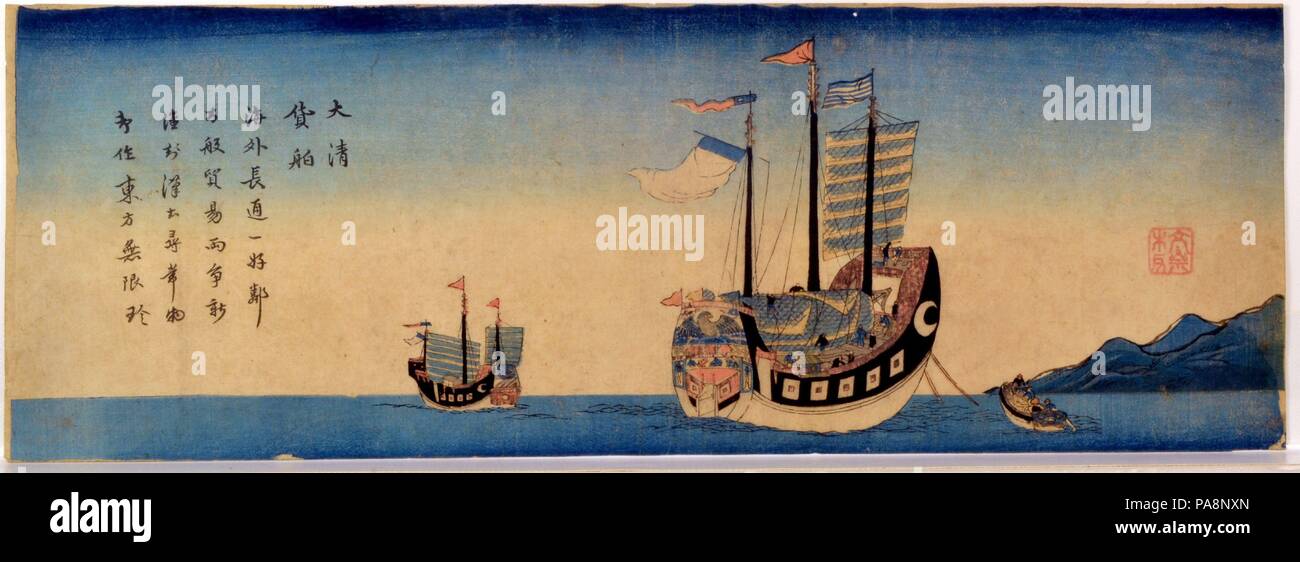 Chinese Ships at Nagasaki. Artist: Unidentified Artist Japanese, 19th century. Culture: Japan. Dimensions: Sheet: 6 3/8 x 18 3/16 in. (16.2 x 46.2 cm). Date: ca. 1840. Two Chinese ships approach the port of Nagasaki. The crew works quickly to lower one of the sails of the ship in the foreground as a small vessel approaches with a group of returning traders. Above the slopes of the shore at the right of the print is a red seal with the name of the print's publisher. It reads 'Bunsaido'. An inscription at the upper left of the print declares the ships to be trading vessels from Qing China. I Stock Photohttps://www.alamy.com/image-license-details/?v=1https://www.alamy.com/chinese-ships-at-nagasaki-artist-unidentified-artist-japanese-19th-century-culture-japan-dimensions-sheet-6-38-x-18-316-in-162-x-462-cm-date-ca-1840-two-chinese-ships-approach-the-port-of-nagasaki-the-crew-works-quickly-to-lower-one-of-the-sails-of-the-ship-in-the-foreground-as-a-small-vessel-approaches-with-a-group-of-returning-traders-above-the-slopes-of-the-shore-at-the-right-of-the-print-is-a-red-seal-with-the-name-of-the-prints-publisher-it-reads-bunsaido-an-inscription-at-the-upper-left-of-the-print-declares-the-ships-to-be-trading-vessels-from-qing-china-i-image212863805.html
Chinese Ships at Nagasaki. Artist: Unidentified Artist Japanese, 19th century. Culture: Japan. Dimensions: Sheet: 6 3/8 x 18 3/16 in. (16.2 x 46.2 cm). Date: ca. 1840. Two Chinese ships approach the port of Nagasaki. The crew works quickly to lower one of the sails of the ship in the foreground as a small vessel approaches with a group of returning traders. Above the slopes of the shore at the right of the print is a red seal with the name of the print's publisher. It reads 'Bunsaido'. An inscription at the upper left of the print declares the ships to be trading vessels from Qing China. I Stock Photohttps://www.alamy.com/image-license-details/?v=1https://www.alamy.com/chinese-ships-at-nagasaki-artist-unidentified-artist-japanese-19th-century-culture-japan-dimensions-sheet-6-38-x-18-316-in-162-x-462-cm-date-ca-1840-two-chinese-ships-approach-the-port-of-nagasaki-the-crew-works-quickly-to-lower-one-of-the-sails-of-the-ship-in-the-foreground-as-a-small-vessel-approaches-with-a-group-of-returning-traders-above-the-slopes-of-the-shore-at-the-right-of-the-print-is-a-red-seal-with-the-name-of-the-prints-publisher-it-reads-bunsaido-an-inscription-at-the-upper-left-of-the-print-declares-the-ships-to-be-trading-vessels-from-qing-china-i-image212863805.htmlRMPA8NXN–Chinese Ships at Nagasaki. Artist: Unidentified Artist Japanese, 19th century. Culture: Japan. Dimensions: Sheet: 6 3/8 x 18 3/16 in. (16.2 x 46.2 cm). Date: ca. 1840. Two Chinese ships approach the port of Nagasaki. The crew works quickly to lower one of the sails of the ship in the foreground as a small vessel approaches with a group of returning traders. Above the slopes of the shore at the right of the print is a red seal with the name of the print's publisher. It reads 'Bunsaido'. An inscription at the upper left of the print declares the ships to be trading vessels from Qing China. I
 Utagawa Kunisada, Mitsuuji in the Maruyama Pleasure District of Nagasaki (Nagasaki dejima), Japan, Edo period (1615–1868), Utagawa Kunisada (Japanese, 1786–1864), Utagawa Hiroshige II (Japanese, 1829–1869), 3rd month, 1861, Japan, Triptych of polychrome woodblock prints; ink and color on paper, Image (a): 14 1/2 x 10 in. (36.8 x 25.4 cm), Image (b): 14 5/8 x 10 1/8 in. (37.1 x 25.7 cm), Image (c): 14 3/4 x 10 in. (37.5 x 25.4 cm), Prints Stock Photohttps://www.alamy.com/image-license-details/?v=1https://www.alamy.com/utagawa-kunisada-mitsuuji-in-the-maruyama-pleasure-district-of-nagasaki-nagasaki-dejima-japan-edo-period-16151868-utagawa-kunisada-japanese-17861864-utagawa-hiroshige-ii-japanese-18291869-3rd-month-1861-japan-triptych-of-polychrome-woodblock-prints-ink-and-color-on-paper-image-a-14-12-x-10-in-368-x-254-cm-image-b-14-58-x-10-18-in-371-x-257-cm-image-c-14-34-x-10-in-375-x-254-cm-prints-image344666354.html
Utagawa Kunisada, Mitsuuji in the Maruyama Pleasure District of Nagasaki (Nagasaki dejima), Japan, Edo period (1615–1868), Utagawa Kunisada (Japanese, 1786–1864), Utagawa Hiroshige II (Japanese, 1829–1869), 3rd month, 1861, Japan, Triptych of polychrome woodblock prints; ink and color on paper, Image (a): 14 1/2 x 10 in. (36.8 x 25.4 cm), Image (b): 14 5/8 x 10 1/8 in. (37.1 x 25.7 cm), Image (c): 14 3/4 x 10 in. (37.5 x 25.4 cm), Prints Stock Photohttps://www.alamy.com/image-license-details/?v=1https://www.alamy.com/utagawa-kunisada-mitsuuji-in-the-maruyama-pleasure-district-of-nagasaki-nagasaki-dejima-japan-edo-period-16151868-utagawa-kunisada-japanese-17861864-utagawa-hiroshige-ii-japanese-18291869-3rd-month-1861-japan-triptych-of-polychrome-woodblock-prints-ink-and-color-on-paper-image-a-14-12-x-10-in-368-x-254-cm-image-b-14-58-x-10-18-in-371-x-257-cm-image-c-14-34-x-10-in-375-x-254-cm-prints-image344666354.htmlRM2B0MWCJ–Utagawa Kunisada, Mitsuuji in the Maruyama Pleasure District of Nagasaki (Nagasaki dejima), Japan, Edo period (1615–1868), Utagawa Kunisada (Japanese, 1786–1864), Utagawa Hiroshige II (Japanese, 1829–1869), 3rd month, 1861, Japan, Triptych of polychrome woodblock prints; ink and color on paper, Image (a): 14 1/2 x 10 in. (36.8 x 25.4 cm), Image (b): 14 5/8 x 10 1/8 in. (37.1 x 25.7 cm), Image (c): 14 3/4 x 10 in. (37.5 x 25.4 cm), Prints
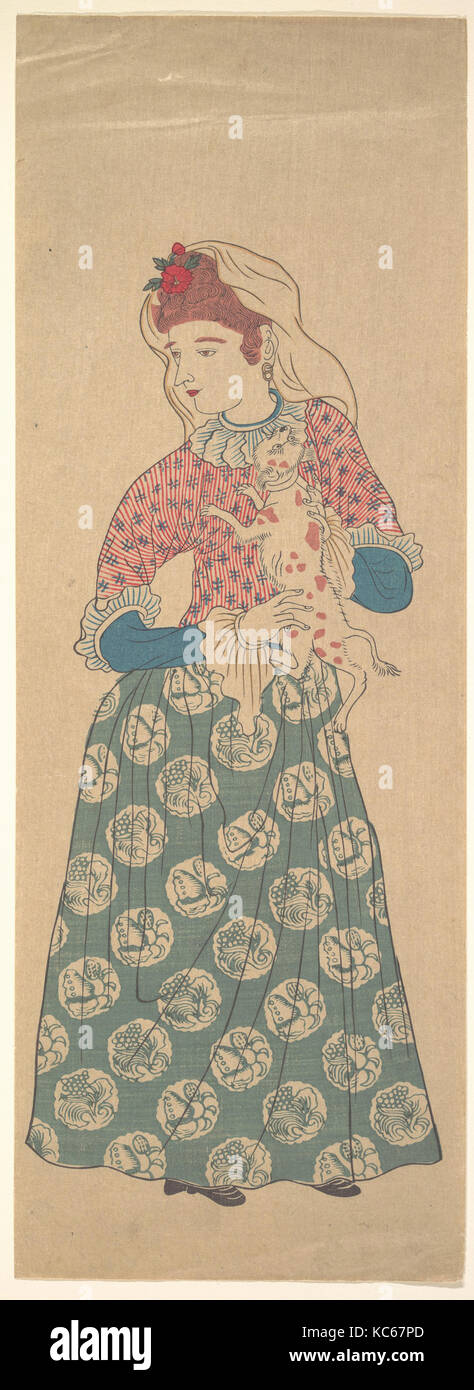 Dutch Woman Holding a Dog, Unidentified Artist, first half of the 19th century Stock Photohttps://www.alamy.com/image-license-details/?v=1https://www.alamy.com/stock-image-dutch-woman-holding-a-dog-unidentified-artist-first-half-of-the-19th-162407013.html
Dutch Woman Holding a Dog, Unidentified Artist, first half of the 19th century Stock Photohttps://www.alamy.com/image-license-details/?v=1https://www.alamy.com/stock-image-dutch-woman-holding-a-dog-unidentified-artist-first-half-of-the-19th-162407013.htmlRMKC67PD–Dutch Woman Holding a Dog, Unidentified Artist, first half of the 19th century
 Dutchman with a Servant. Artist: Attributed to Kawahara Keiga (Japanese, 1786-1860). Culture: Japan. Dimensions: Image: 19 3/4 x 9 7/8 in. (50.2 x 25.1 cm). Date: early 19th century. This is painting was inspired by an early print of the 1750s entitled 'Hollander' (Orandajin no zu) that was produced by the publisher Hariya in Nagasaki, the only port foreigners were allowed to enter Japan for most of the Edo period. That print, which became a template for countless subsequent prints and paintings of Dutch figures, identifies the dandily dressed figure with bright blue eyes and long, curly blon Stock Photohttps://www.alamy.com/image-license-details/?v=1https://www.alamy.com/dutchman-with-a-servant-artist-attributed-to-kawahara-keiga-japanese-1786-1860-culture-japan-dimensions-image-19-34-x-9-78-in-502-x-251-cm-date-early-19th-century-this-is-painting-was-inspired-by-an-early-print-of-the-1750s-entitled-hollander-orandajin-no-zu-that-was-produced-by-the-publisher-hariya-in-nagasaki-the-only-port-foreigners-were-allowed-to-enter-japan-for-most-of-the-edo-period-that-print-which-became-a-template-for-countless-subsequent-prints-and-paintings-of-dutch-figures-identifies-the-dandily-dressed-figure-with-bright-blue-eyes-and-long-curly-blon-image213323638.html
Dutchman with a Servant. Artist: Attributed to Kawahara Keiga (Japanese, 1786-1860). Culture: Japan. Dimensions: Image: 19 3/4 x 9 7/8 in. (50.2 x 25.1 cm). Date: early 19th century. This is painting was inspired by an early print of the 1750s entitled 'Hollander' (Orandajin no zu) that was produced by the publisher Hariya in Nagasaki, the only port foreigners were allowed to enter Japan for most of the Edo period. That print, which became a template for countless subsequent prints and paintings of Dutch figures, identifies the dandily dressed figure with bright blue eyes and long, curly blon Stock Photohttps://www.alamy.com/image-license-details/?v=1https://www.alamy.com/dutchman-with-a-servant-artist-attributed-to-kawahara-keiga-japanese-1786-1860-culture-japan-dimensions-image-19-34-x-9-78-in-502-x-251-cm-date-early-19th-century-this-is-painting-was-inspired-by-an-early-print-of-the-1750s-entitled-hollander-orandajin-no-zu-that-was-produced-by-the-publisher-hariya-in-nagasaki-the-only-port-foreigners-were-allowed-to-enter-japan-for-most-of-the-edo-period-that-print-which-became-a-template-for-countless-subsequent-prints-and-paintings-of-dutch-figures-identifies-the-dandily-dressed-figure-with-bright-blue-eyes-and-long-curly-blon-image213323638.htmlRMPB1MDA–Dutchman with a Servant. Artist: Attributed to Kawahara Keiga (Japanese, 1786-1860). Culture: Japan. Dimensions: Image: 19 3/4 x 9 7/8 in. (50.2 x 25.1 cm). Date: early 19th century. This is painting was inspired by an early print of the 1750s entitled 'Hollander' (Orandajin no zu) that was produced by the publisher Hariya in Nagasaki, the only port foreigners were allowed to enter Japan for most of the Edo period. That print, which became a template for countless subsequent prints and paintings of Dutch figures, identifies the dandily dressed figure with bright blue eyes and long, curly blon
![Russians at Nagasaki. Artist: Unidentified Artist Japanese, 19th century. Culture: Japan. Dimensions: Image: 10 3/4 x 7 3/4 in. (27.3 x 19.7 cm); Sheet: 12 7/8 x 8 3/16 in. (32.7 x 20.8 cm). Date: ca. 1830. Russian officer Nikolay Rezanov (1764-1807) stands in the port of Nagasaki. He faces a soldier on the left, and his attendant holds a Russian flag on the right. Clouds billow in the sky and the wind fills the sails of a ship. A yellow cartouche at the upper left reads, 'Illustration of Russians who arrived at Nagasaki in the ninth month of the first year of the Bunka era [1804].' The work Stock Photo Russians at Nagasaki. Artist: Unidentified Artist Japanese, 19th century. Culture: Japan. Dimensions: Image: 10 3/4 x 7 3/4 in. (27.3 x 19.7 cm); Sheet: 12 7/8 x 8 3/16 in. (32.7 x 20.8 cm). Date: ca. 1830. Russian officer Nikolay Rezanov (1764-1807) stands in the port of Nagasaki. He faces a soldier on the left, and his attendant holds a Russian flag on the right. Clouds billow in the sky and the wind fills the sails of a ship. A yellow cartouche at the upper left reads, 'Illustration of Russians who arrived at Nagasaki in the ninth month of the first year of the Bunka era [1804].' The work Stock Photo](https://c8.alamy.com/comp/PB1R39/russians-at-nagasaki-artist-unidentified-artist-japanese-19th-century-culture-japan-dimensions-image-10-34-x-7-34-in-273-x-197-cm-sheet-12-78-x-8-316-in-327-x-208-cm-date-ca-1830-russian-officer-nikolay-rezanov-1764-1807-stands-in-the-port-of-nagasaki-he-faces-a-soldier-on-the-left-and-his-attendant-holds-a-russian-flag-on-the-right-clouds-billow-in-the-sky-and-the-wind-fills-the-sails-of-a-ship-a-yellow-cartouche-at-the-upper-left-reads-illustration-of-russians-who-arrived-at-nagasaki-in-the-ninth-month-of-the-first-year-of-the-bunka-era-1804-the-work-PB1R39.jpg) Russians at Nagasaki. Artist: Unidentified Artist Japanese, 19th century. Culture: Japan. Dimensions: Image: 10 3/4 x 7 3/4 in. (27.3 x 19.7 cm); Sheet: 12 7/8 x 8 3/16 in. (32.7 x 20.8 cm). Date: ca. 1830. Russian officer Nikolay Rezanov (1764-1807) stands in the port of Nagasaki. He faces a soldier on the left, and his attendant holds a Russian flag on the right. Clouds billow in the sky and the wind fills the sails of a ship. A yellow cartouche at the upper left reads, 'Illustration of Russians who arrived at Nagasaki in the ninth month of the first year of the Bunka era [1804].' The work Stock Photohttps://www.alamy.com/image-license-details/?v=1https://www.alamy.com/russians-at-nagasaki-artist-unidentified-artist-japanese-19th-century-culture-japan-dimensions-image-10-34-x-7-34-in-273-x-197-cm-sheet-12-78-x-8-316-in-327-x-208-cm-date-ca-1830-russian-officer-nikolay-rezanov-1764-1807-stands-in-the-port-of-nagasaki-he-faces-a-soldier-on-the-left-and-his-attendant-holds-a-russian-flag-on-the-right-clouds-billow-in-the-sky-and-the-wind-fills-the-sails-of-a-ship-a-yellow-cartouche-at-the-upper-left-reads-illustration-of-russians-who-arrived-at-nagasaki-in-the-ninth-month-of-the-first-year-of-the-bunka-era-1804-the-work-image213325709.html
Russians at Nagasaki. Artist: Unidentified Artist Japanese, 19th century. Culture: Japan. Dimensions: Image: 10 3/4 x 7 3/4 in. (27.3 x 19.7 cm); Sheet: 12 7/8 x 8 3/16 in. (32.7 x 20.8 cm). Date: ca. 1830. Russian officer Nikolay Rezanov (1764-1807) stands in the port of Nagasaki. He faces a soldier on the left, and his attendant holds a Russian flag on the right. Clouds billow in the sky and the wind fills the sails of a ship. A yellow cartouche at the upper left reads, 'Illustration of Russians who arrived at Nagasaki in the ninth month of the first year of the Bunka era [1804].' The work Stock Photohttps://www.alamy.com/image-license-details/?v=1https://www.alamy.com/russians-at-nagasaki-artist-unidentified-artist-japanese-19th-century-culture-japan-dimensions-image-10-34-x-7-34-in-273-x-197-cm-sheet-12-78-x-8-316-in-327-x-208-cm-date-ca-1830-russian-officer-nikolay-rezanov-1764-1807-stands-in-the-port-of-nagasaki-he-faces-a-soldier-on-the-left-and-his-attendant-holds-a-russian-flag-on-the-right-clouds-billow-in-the-sky-and-the-wind-fills-the-sails-of-a-ship-a-yellow-cartouche-at-the-upper-left-reads-illustration-of-russians-who-arrived-at-nagasaki-in-the-ninth-month-of-the-first-year-of-the-bunka-era-1804-the-work-image213325709.htmlRMPB1R39–Russians at Nagasaki. Artist: Unidentified Artist Japanese, 19th century. Culture: Japan. Dimensions: Image: 10 3/4 x 7 3/4 in. (27.3 x 19.7 cm); Sheet: 12 7/8 x 8 3/16 in. (32.7 x 20.8 cm). Date: ca. 1830. Russian officer Nikolay Rezanov (1764-1807) stands in the port of Nagasaki. He faces a soldier on the left, and his attendant holds a Russian flag on the right. Clouds billow in the sky and the wind fills the sails of a ship. A yellow cartouche at the upper left reads, 'Illustration of Russians who arrived at Nagasaki in the ninth month of the first year of the Bunka era [1804].' The work
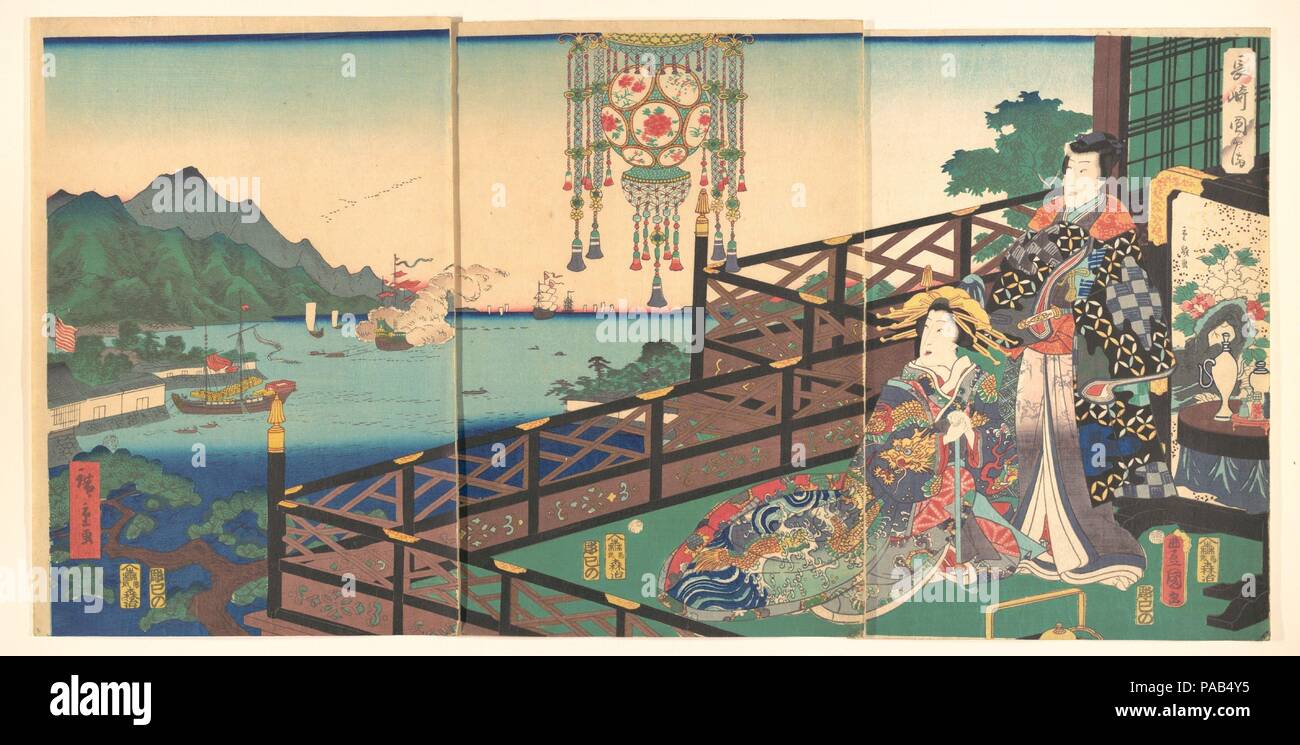 Mitsuuji in the Maruyama Pleasure District of Nagasaki (Nagasaki dejima). Artist: Utagawa Kunisada (Japanese, 1786-1865); Utagawa Hiroshige II (Japanese, 1829-1869). Culture: Japan. Dimensions: Image (a): 14 1/2 x 10 in. (36.8 x 25.4 cm) Image (b): 14 5/8 x 10 1/8 in. (37.1 x 25.7 cm) Image (c): 14 3/4 x 10 in. (37.5 x 25.4 cm). Date: 3rd month, 1861. Museum: Metropolitan Museum of Art, New York, USA. Stock Photohttps://www.alamy.com/image-license-details/?v=1https://www.alamy.com/mitsuuji-in-the-maruyama-pleasure-district-of-nagasaki-nagasaki-dejima-artist-utagawa-kunisada-japanese-1786-1865-utagawa-hiroshige-ii-japanese-1829-1869-culture-japan-dimensions-image-a-14-12-x-10-in-368-x-254-cm-image-b-14-58-x-10-18-in-371-x-257-cm-image-c-14-34-x-10-in-375-x-254-cm-date-3rd-month-1861-museum-metropolitan-museum-of-art-new-york-usa-image212916345.html
Mitsuuji in the Maruyama Pleasure District of Nagasaki (Nagasaki dejima). Artist: Utagawa Kunisada (Japanese, 1786-1865); Utagawa Hiroshige II (Japanese, 1829-1869). Culture: Japan. Dimensions: Image (a): 14 1/2 x 10 in. (36.8 x 25.4 cm) Image (b): 14 5/8 x 10 1/8 in. (37.1 x 25.7 cm) Image (c): 14 3/4 x 10 in. (37.5 x 25.4 cm). Date: 3rd month, 1861. Museum: Metropolitan Museum of Art, New York, USA. Stock Photohttps://www.alamy.com/image-license-details/?v=1https://www.alamy.com/mitsuuji-in-the-maruyama-pleasure-district-of-nagasaki-nagasaki-dejima-artist-utagawa-kunisada-japanese-1786-1865-utagawa-hiroshige-ii-japanese-1829-1869-culture-japan-dimensions-image-a-14-12-x-10-in-368-x-254-cm-image-b-14-58-x-10-18-in-371-x-257-cm-image-c-14-34-x-10-in-375-x-254-cm-date-3rd-month-1861-museum-metropolitan-museum-of-art-new-york-usa-image212916345.htmlRMPAB4Y5–Mitsuuji in the Maruyama Pleasure District of Nagasaki (Nagasaki dejima). Artist: Utagawa Kunisada (Japanese, 1786-1865); Utagawa Hiroshige II (Japanese, 1829-1869). Culture: Japan. Dimensions: Image (a): 14 1/2 x 10 in. (36.8 x 25.4 cm) Image (b): 14 5/8 x 10 1/8 in. (37.1 x 25.7 cm) Image (c): 14 3/4 x 10 in. (37.5 x 25.4 cm). Date: 3rd month, 1861. Museum: Metropolitan Museum of Art, New York, USA.